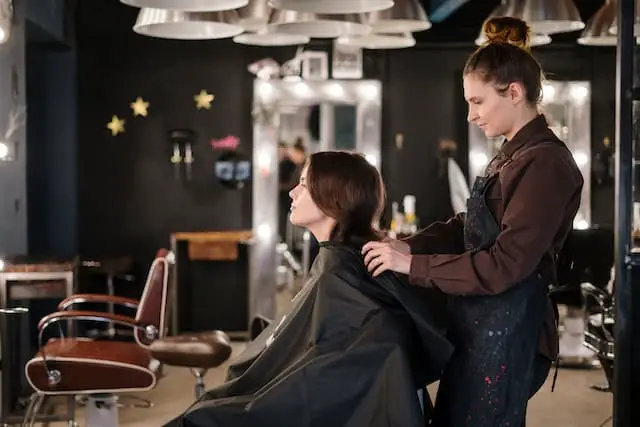Modern salons are the workplaces of stylists, makeup artists, and fashion designers, and other people go there to get haircuts and do makeup. In the past, salons were social gatherings in 18th-century France that influential women traditionally hosted. Attendees often engaged in in-depth philosophical discussions, debated scientific theories, and debated social issues. Thus, the salons grew in significance as a breeding ground for revolutionary thought and discourse. It makes perfect sense to learn about the origin of salons by reading about them in full in this history of the salon post.
History Of The Salon- Overview
If you’re familiar with the term “salon,” the French salons of the 17th and 18th centuries are probably what first come to mind. Here, thinkers from all walks of life could gather to discuss and debate the latest developments in philosophy, music, poetry, prose, politics, art, and other fields.
Salons served as a central forum for the free flow of information and discussion. A product of 16th-century Italy, salons were at their height in France during the subsequent centuries. Salons were widespread in Europe, but they held special sway in France. Throughout the 19 century, Italy was a hotbed of salon activity.
Indepth History of the Salon
Salons have been around for centuries, where people gather to share and discuss new works of literature and music and debate and discuss ideas. Salons are a fad that wax and wane throughout history, but they were widely popular in Europe from about 1500 to 1900. The word “salon” implies that get-togethers occur on a somewhat consistent basis, such as once a week or once a month. Salons could have a focused discussion on a particular topic, like poetry, or they could be more open-ended. However, the common thread among these salon activities was an emphasis on getting to know one another through conversation and active listening.
Roots in Italy
While the salon has origins in classical antiquity (particularly in Ancient Greece and Rome), the earliest surviving examples date back to 15th-century Italy. It served as a forerunner to the Enlightenment. They provided a setting where people from all walks of life, including artists, poets, musicians, thinkers, and the Renaissance intellectual glitterati, as well as their hangers-on, could mingle and exchange ideas without fear of persecution from the Roman Catholic Church.
Italian Renaissance
Aristocratic women hosted these Italian salons, and the hostess was viewed as a source of creativity, intelligence, and innovation. During the Renaissance in Italy, salons hosted by women like Isabella d’Este (1474-1533) and Elisabetta Gonzaga (1471-1526) reached far and wide. Berta Zuckerkand, an elegant and well-read benefactor, injected new life into Italy’s salon scene. Both were avid letter writers, so many details of their relationship can be learned from their correspondence. Baldassare Castiglionein described these salons in his book The Book of the Courtier, which outlined the proper protocol for attending an Italian Renaissance salon. Their social gatherings are thought to have been so influential that the concept of French salons emerged as a result.
In a male-dominated field, this was a once-in-a-lifetime opportunity for a woman to be in charge while also enjoying personal autonomy and being front and center when pivotal ideas were being discussed. During this time, women were not permitted to attend school, so salons served as a socially acceptable alternative for learning. If you upset the salon owner, they wouldn’t have any sympathy for you and wouldn’t let you back in the door. You also couldn’t just show up to someone’s house for a salon night as a guest. An introduction letter was required.
The First Salon in France
Marquess de Rambouillet, a French aristocrat of Italian descent, is credited with hosting the first literary salon in France in the 1600s. The literary elite of France would gather at Rambouillet’s salon. As time passed, salons became more formal, but those early gatherings were more relaxed.
From the Italian salone, the grand Italian residence foyer, the word salon made its debut in France in 1664. Salone is the augmented form of the word room, sala. Before this, literary events were frequently referred to by the name of the room where they were held, such as a ruelle, cabinet, alcôve, or réduit. In the same vein as their Italian counterparts, these salons were held in the homes of influential, well-educated women. The evening’s conversation, art, and music were all carefully curated by the evening’s female hosts, who were later dubbed salonnières.
Rambouillet Influence
Catherine de Vivonne, the Marquesse de Rambouillet, hosted one of the most infamous early French salons. Catherine, born in Italy, disliked life at the French Court. She invited the educated to her home, which she called the Hotel de Rambouillet, and made it a comfortable place for them to talk freely and openly. By the middle of the 1600s, Catherine’s house had become a hub for the region’s intellectual elite and the most cutting-edge thinkers. Madeleine de Scudéry was the most well-known of the early French salonistas to follow in her footsteps. While she was famous for establishing her own feminist utopia in her salon, she was also known for strictly prohibiting romantic and sexual love.
In the end, de Scudéry followed Marquess de Rambouillet’s footsteps and declared her salon to be its own independent nation within her heart, even creating a map, Tender Card (La Carte de Tendre), to show how to get to that point. An invitation to her salon was still regarded as a badge of aristocratic status in the days of her hosting heyday, and this era was reflected in her party planning. It became a mark of social nobility in and of itself to win her heart by playing La Carte de Tendre.
Early 18th Century
These get-togethers were typically held in the bedroom (viewed as a more intimate version of the drawing room) before the latter half of the 17th century. When a woman was lying in bed, her closest friends would sit on chairs or stools pulled up around her. The early 18th-century French salons were remarkable because they served as a neutral meeting ground for people of varying socioeconomic backgrounds to discuss topics of mutual interest. Salons of the past, like those held at Versailles, catered exclusively to the nobility and other elites. In the privacy of one’s home, one need not worry that an angry neighbor will later sever their head from their body because of a disagreement.
Enlightenment Period
The Enlightenment, which took place from the late 1700s to the early 1800s, was a time of great intellectual ferment and the triumph of reason over dogma. This was lauded as an “independent thinker” who seeks new information and engages in healthy debate. The French believed a more educated and informed society was better for everyone. Being part of the salon set meant being on top of the latest trends and ideas.
Formality in Salons
After the radical upheaval of the French Revolution, Napoleon came to power, and the salons he established became somewhat more formal and subdued in tone. Perhaps they were also less intellectual because Napoleon did not want to foster too much independence of thought among his people and thought the authority hostesses wielded was inherently risky.
In 1803, he exiled a controversial salonista named Germaine de Stal, who was told she was not allowed to come “within 40 leagues of Paris” for the next decade. According to the memoirs of another member of the French royal family, Madame de Rémusat, Napoleon once remarked that she “teaches people to think who have never thought before, or who have forgotten how to think.”
The Return of Salons
After a brief heyday in the middle of the nineteenth century, French salons revived in the latter half of the century as venues for modern art exhibitions and literary events, setting the stage for a new art-focused salon era in the twentieth century. Gertrude Stein and Natalie Clifford Barney, two wealthy Americans, who had relocated to France, were instrumental in keeping the tradition of Paris as the center of the world’s most influential salons alive.
The Temple of Friendship
They became friends because they had so much in common, personally and in terms of salon clientele. Both were outspoken lesbians of Jewish descent who achieved literary superstardom as pioneering feminists. They regularly hosted Scott Fitzgerald, Ezra Pound, Hemingway, F., and many others in their weekly salons. In the garden of Natalie’s Parisian apartment was an old Masonic temple, which she renamed “The Temple of Friendship.” Her salon was open for 60 years; during WWII, Natalie closed it temporarily to escape Nazi occupation and relocate to Italy. In 1949, she relocated back to Paris, where she continued hosting her weekly salon on Friday evenings.
Gertrude’s Salons
Leo Stein, Gertrude Stein’s brother with whom she shared a Paris apartment, was an early patron of Picasso and other significant modern artists, who frequented her weekly salons. While the Steins were early collectors of works by Matisse, Cezanne, and Renoir, Gertrude’s salons in their home attracted some of literature’s brightest minds. From 1910 on, Gertrude shared her life with Alice B. Tolkas, a fellow American author about whom she would write the biography “The Autobiography of Alice B. Tolkas.” Artists and writers frequented Gertrude’s salons in the early 20th century and helped define the modernist movement in art and literature.
When the Germans invaded Paris, Gertrude and Alice stayed there nonetheless. Most of the era’s salons were destroyed along with the rest of Europe during World War II. Their heyday coincided with the Weimar Republic’s salons and A’lelia Walker’s Harlem Renaissance salons, which hosted luminaries like Zora Neale Hurston between 1915 and 1930. With her assistance, A’lelia Walker became the leading art patron, philanthropist, and salonista of her era and the co-founder of a direct-to-consumer beauty products company worth millions of dollars.
Harlem Renaissance
Not only was she not the only woman in Harlem at the time hosting salons, but so were Georgia Douglas Johnson, Ruth Logan Roberts, and Zora Neale Hurston. Harlem Renaissance, a cultural renaissance of African Americans, may have been fueled in part by the activities of these salons. In the mid-20th century, salons reemerged in Hollywood and New York City. Still, many were shut down during the Red Scare when they were falsely linked to Communism by the House Un-American Activities Committee. The FBI took an interest in Salka Viertel’s Santa Monica salon, where World War II refugees turned into Hollywood stars.
Bottom Line
Salons may appear to be purely functional locations for getting a haircut today, but this is not their original purpose. The history of the salons tells of a totally different story. Origins of the hairstyles and cosmetics sold there have nothing to do with its history. Yet, one activity that is still common in salons is the exchange of ideas and the discussion of controversial topics. The wealthy of a society can afford to meet at exclusive salons once a week or once a month. Africa and Asia are home to some of the highest per capita rates of salon visits worldwide.







